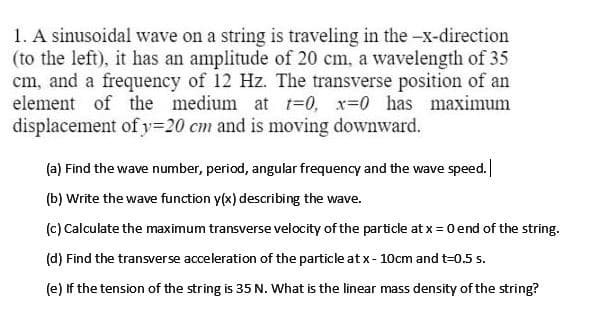1. A sinusoidal wave on a string is traveling in the -x-direction (to the left), it has an amplitude of 20 cm, a wavelength of 35 cm, and a frequency of 12 Hz. The transverse position of an element of the medium at t=0, x-0 has maximum displacement ofy%320 cm and is moving downward. (a) Find the wave number, period, angular frequency and the wave speed. (b) Write the wave function y(x) describing the wave. (c) Calculate the maximum transverse velocity of the particle at x = 0 end of the string.
1. A sinusoidal wave on a string is traveling in the -x-direction (to the left), it has an amplitude of 20 cm, a wavelength of 35 cm, and a frequency of 12 Hz. The transverse position of an element of the medium at t=0, x-0 has maximum displacement ofy%320 cm and is moving downward. (a) Find the wave number, period, angular frequency and the wave speed. (b) Write the wave function y(x) describing the wave. (c) Calculate the maximum transverse velocity of the particle at x = 0 end of the string.
Physics for Scientists and Engineers, Technology Update (No access codes included)
9th Edition
ISBN:9781305116399
Author:Raymond A. Serway, John W. Jewett
Publisher:Raymond A. Serway, John W. Jewett
Chapter16: Wave Motion
Section: Chapter Questions
Problem 16.13P
Related questions
Concept explainers
Interference of sound
Seiche
A seiche is an oscillating standing wave in a body of water. The term seiche pronounced saysh) can be understood by the sloshing of water back and forth in a swimming pool. The same phenomenon happens on a much larger scale in vast bodies of water including bays and lakes. A seizure can happen in any enclosed or semi-enclosed body of water.
Question

Transcribed Image Text:1. A sinusoidal wave on a string is traveling in the -x-direction
(to the left), it has an amplitude of 20 cm, a wavelength of 35
cm, and a frequency of 12 Hz. The transverse position of an
element of the medium at t=0, x=0 has maximum
displacement ofy=20 cm and is moving downward.
(a) Find the wave number, period, angular frequency and the wave speed.
(b) Write the wave function y(x) describing the wave.
(c) Calculate the maximum transverse velocity of the particle at x = 0 end of the string.
(d) Find the transverse acceleration of the particle at x- 10cm and t=0.5 s.
(e) If the tension of the string is 35 N. What is the linear mass density of the string?
Expert Solution
This question has been solved!
Explore an expertly crafted, step-by-step solution for a thorough understanding of key concepts.
This is a popular solution!
Trending now
This is a popular solution!
Step by step
Solved in 2 steps

Knowledge Booster
Learn more about
Need a deep-dive on the concept behind this application? Look no further. Learn more about this topic, physics and related others by exploring similar questions and additional content below.Recommended textbooks for you

Physics for Scientists and Engineers, Technology …
Physics
ISBN:
9781305116399
Author:
Raymond A. Serway, John W. Jewett
Publisher:
Cengage Learning

Physics for Scientists and Engineers: Foundations…
Physics
ISBN:
9781133939146
Author:
Katz, Debora M.
Publisher:
Cengage Learning

Principles of Physics: A Calculus-Based Text
Physics
ISBN:
9781133104261
Author:
Raymond A. Serway, John W. Jewett
Publisher:
Cengage Learning

Physics for Scientists and Engineers, Technology …
Physics
ISBN:
9781305116399
Author:
Raymond A. Serway, John W. Jewett
Publisher:
Cengage Learning

Physics for Scientists and Engineers: Foundations…
Physics
ISBN:
9781133939146
Author:
Katz, Debora M.
Publisher:
Cengage Learning

Principles of Physics: A Calculus-Based Text
Physics
ISBN:
9781133104261
Author:
Raymond A. Serway, John W. Jewett
Publisher:
Cengage Learning

University Physics Volume 1
Physics
ISBN:
9781938168277
Author:
William Moebs, Samuel J. Ling, Jeff Sanny
Publisher:
OpenStax - Rice University

College Physics
Physics
ISBN:
9781305952300
Author:
Raymond A. Serway, Chris Vuille
Publisher:
Cengage Learning

Physics for Scientists and Engineers
Physics
ISBN:
9781337553278
Author:
Raymond A. Serway, John W. Jewett
Publisher:
Cengage Learning